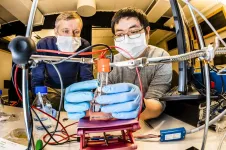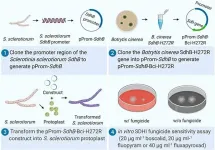(Press-News.org) Terence D. Capellini has been interested in how joints work for almost three decades. Part of it is due to personal experience, having sustained several joint injuries as a college ice hockey player and recently developing knee osteoarthritis. But the principal investigator of Harvard's Developmental and Evolutionary Genetics Lab has also seen the pain and limited mobility of loved ones who've received similar diagnoses and injuries.
"We have all these joints in the body and they don't look the same from one another," said Capellini, the Richard B. Wolf Associate Professor in the Department of Human Evolutionary Biology. "Two very interesting inter-related questions are: Why do certain joints naturally acquire some disease while others do not, and why are some joints more prone to injury than others?"
These type of questions, along with a passion to understand the skeleton, motivated Capellini to lead a study on joint disorders that published Tuesday in Nature Communications. The findings from the paper could one day lead to therapeutics for two difficult-to-treat joint disorders that primarily affect the world's oldest and youngest populations.
The report details regulatory variants found near a gene, which plays a crucial role joint formation called GDF5. The study pinpoints two separate mutations near the gene, one that can cause knee osteoarthritis in older adults and another that can cause hip dysplasia in babies. Knee osteoarthritis, a degenerative disease in the knee joint, affects more than 30 percent of people over the age of 65, while hip dysplasia, a structural hip disorder, is present in one out of 1,000 newborns.
The findings can lay the groundwork for possible screenings of these diseases, which could allow for medical and non-medical interventions since patients will know they are at risk. The results could also lead to the creation of potential treatments because scientists will be able to better understand, target, and possibly affect the expression of the gene mutations to prevent the diseases.
"We can begin to understand whether we can start targeting these genetic regions for therapy," Capellini said.
The team of researchers say the mutations that lead to the diseases originate within two distinct regulatory switches near the GDF5 gene. One of the switches affects a population of cells that make the knee joint form its shape, while the other switch affects the cells that make the bones growing around the hip fit correctly.
"You can think of these switches as similar to the light switches in your house, with the light bulb being the gene," Capellini said. "You may have the same 100-watt light bulb in each room, but the kitchen switch only turns on the light bulb in the kitchen, while the living room switch only turns it on in the living room."
The discovery gives the researchers clues about the biological importance of these switches as target areas for therapies because they are prone to disruption.
The report is a collaboration between scientists from Harvard's Faculty of Arts and Sciences, the Broad Institute, the Harvard School of Dental Medicine, Harvard Medical School, Boston Children's Hospital, and medical researchers in China. Pushpanathan Muthuirulan, a research associate in Capellini's lab, was first author on the study, and Ata Kiapour, an assistant professor of orthopedic surgery at HMS and Children's Hospital, did the bulk of the medical imaging work.
The research team started by examining data acquired from genome-wide association studies on knee osteoarthritis and hip dysplasia. The goal of these types of studies are to detect and map genetic mutations across the genome that are associated with disease risk or variation in a trait. They chose the GDF5 gene because it's a region of the genome associated with about 20 different skeletal traits and has hundreds of potential disease-causing mutations.
Capellini and his colleagues identified the regulatory on and off switches across the genome responsible for building different joints in the human body, such as the hip, knee, shoulder, and elbow. With that information and the genome-wide association data, they used CRISPR gene editing techniques to modify human cartilage cells in a dish and to engineer mice to have separate mutations in each of the knee and hip switches they found.
These humanized mouse models allowed the researchers to study how each mutation impacts the formation and pathology of each joint. They were able to see if the DNA sequences in those switches possessed genetic mutations that have been associated with risk of knee osteoarthritis or risk of hip dysplasia. Through the process of elimination and arduous functional testing, they found the two separate mutations that can lead to both diseases.
The researchers also applied similar computational methods to other genes beyond GDF5. They found that nearly three-quarters of examined genes that are involved in multiple muscular skeletal diseases show the same patterns between potential disease-causing mutations and separate on and off switches for different joints.
The next steps for the researchers involve continuing to broaden their study to apply these experimental techniques to other regions of the genome to see if these patterns hold when it comes to knee osteoarthritis, hip dysplasia, and other skeletal diseases.
"On the broader scale, we want to explore more all these other regions of the genome because the risk for osteoarthritis and hip dysplasia is not just due to one mutation in one region of the genome," Capellini said. "It's a complex polygenic trait, so there's lots of regions of the genome that are conferring your risk for hip dysplasia or osteoarthritis. We want to be able to start modeling these mutations in more complex ways."
INFORMATION:
Pediatric melanoma is a rare disease with only around 400 cases diagnosed in the United States every year. To better understand this disease and how best to treat it, St. Jude Children's Research Hospital scientists created a registry called Molecular Analysis of Childhood MELanocytic Tumors (MACMEL). A paper on findings from the registry was published today in Cancer.
"What is different about the MACMEL registry is that it is prospective," said corresponding author Alberto Pappo, M.D., St. Jude Solid Tumor Division director. "We're seeing the vast majority of enrolled patients as part of the melanoma clinic at St. Jude. We can follow these patients and conduct detailed pathology and molecular analysis."
More ...
University of California San Diego School of Medicine researchers have identified a possible link between inadequate exposure to ultraviolet-B (UVB) light from the sun and an increased risk of colorectal cancer, especially as people age.
Reporting in the journal BMC Public Health, researchers investigated global associations between levels of UVB light -- one of several types of ultraviolet light that reach the Earth's surface -- in 2017 and rates of colorectal cancer across several age groups in 186 countries in 2018.
Lower UVB exposure was significantly correlated with higher rates of colorectal ...
Manufacturing - Powered by nature
A team of researchers at Oak Ridge National Laboratory demonstrated the ability to additively manufacture power poles from bioderived and recycled materials, which could more quickly restore electricity after natural disasters.
Using the Big Area Additive Manufacturing system, the team 3D printed a 55-foot pole designed as a closed cylindrical structure. They evaluated three different composite materials with glass fibers including cellulose ester, recycled polycarbonate and bamboo fiber reinforced polystyrene.
"We developed a modular design that is easy to manufacture, transport and assemble," ORNL's Halil Tekinalp said. "Sections within the pole can ...
BOSTON - A skin pigmentation mechanism that can darken the color of human skin as a natural defense against ultraviolet (UV)-associated cancers has been discovered by scientists at Massachusetts General Hospital (MGH). Mediating the biological process is an enzyme, NNT, which plays a key role in the production of melanin (a pigment that protects the skin from harmful UV rays) and whose inhibition through a topical drug or ointment could potentially reduce the risk of skin cancers. The study was published online in Cell.
"Skin pigmentation and its regulation are critically important because pigments confer major protection against UV-related cancers ...
A transplant of healthy gut microbes followed by fibre supplements benefits patients with severe obesity and metabolic syndrome, according to University of Alberta clinical trial findings published today in Nature Medicine.
Patients who were given a single-dose oral fecal microbial transplant followed by a daily fibre supplement were found to have better insulin sensitivity and higher levels of beneficial microbes in their gut at the end of the six-week trial. Improved insulin sensitivity allows the body to use glucose more effectively, reducing blood sugar.
"They were much more metabolically healthy," said principal investigator Karen Madsen, professor of medicine in the Faculty of Medicine ...
Researchers at Linköping University have developed a method that may lead to new types of displays based on structural colours. The discovery opens the way to cheap and energy-efficient colour displays and electronic labels. The study has been published in the scientific journal Advanced Materials.
We usually think of colours as created by pigments, which absorb light at certain wavelengths such that we perceive colour from other wavelengths that are scattered and reach our eyes. That's why leaves, for example, are green and tomatoes red. But colours can be created ...
Succinate dehydrogenase inhibitors (SDHIs) are a class of fungicides widely used to control many fungal diseases of crops. The relationship between SDHIs and fungi can be compared to finding the right key for the right lock. However, fungi are adaptable and develop resistance to fungicides often by changing the lock so that the SDHI is no longer able to open the door. Because of this adaptability, it is important to understand the biological mechanisms of fungicide resistance.
A recent collaboration between scientists in Michigan and Massachusetts as ...
However, the majority of these organisms are believed to be in a state a state of 'dormancy' due to environmental stress, such as nutrient-poor conditions. An international team of scientists led by Dagmar Woebken and Stephanie A. Eichorst from the University of Vienna investigated how acidobacteria, which are widespread in soils, can survive under adverse conditions. Two recent studies published in The ISME Journal and mSystems describe these survival strategies.
The living conditions that microorganisms encounter in soils are unpredictable and challenging. Nutrients and oxygen are frequently scarce for long periods. Acidobacteria manage to defy these extreme conditions. They are found in an astonishing diversity in soils worldwide. "Since they are this widespread, ...
The death of cells is well regulated. If it occurs too much, it can cause degenerative diseases. Too little, and cells can become tumours. Mitochondria, the power plants of cells, play a role in this programmed cell death. Scientists from the University of Groningen (the Netherlands) and the University of Pittsburgh (U.S.) have obtained new insights in how mitochondria receive the signal to self-destruct. Their results were published in the Journal of Molecular Biology.
How does a cell kill itself? The details of this process are still unclear. Patrick van der Wel, associate professor ...
PLYMOUTH MEETING, PA [July 6, 2021] -- New research in the June 2021 issue of JNCCN--Journal of the National Comprehensive Cancer Network assesses the quality of cancer care delivered through extended sites coordinated by some of the country's largest cancer centers. The study was developed to implement strategies for disseminating discoveries and expanding access to the highest quality cancer care as part of AACI's Network Care Initiative, established by former AACI President Stanton L. Gerson, MD, Director of the Case Comprehensive Cancer Center. Results were calculated based on responses to a mixed-methods survey answered by 69 cancer centers between September 2017 and December 2018, at which time 56 reported at ...





